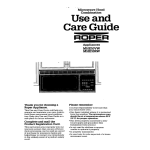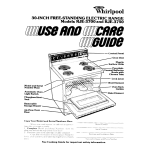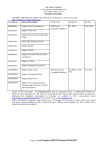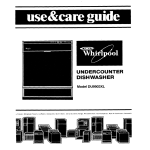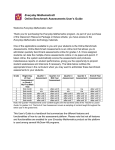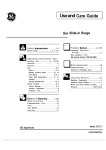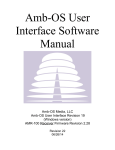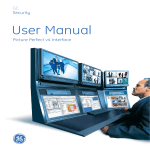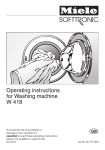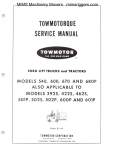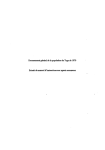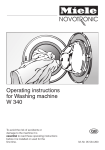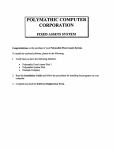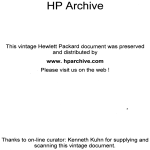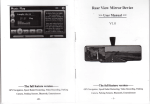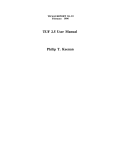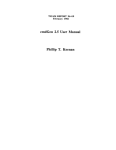Download kScript 2.5 User Manual PhilipT. Keenan
Transcript
TICAM REPORT 96-08 February 1996 kScript 2.5 User Manual PhilipT. Keenan kScript 2.5 User Manual1 Philip T. Keenan2 February .5, 1996 1 This research wjts supported in part by the Department of Energy, the State of Texas Governor's Energy Office, and project grants from the National Science Foundation. The author was also supported in part by an NSF Postdoctoral Fellowship. 2Texas Institute for Computational and Applied Mathematics, The University of Texas at Austin, Taylor Hall 2.400, Austin, Texas 78712. http://www .ticam. utexas . edu/users/keenan/kScript. html Contents 1 Introd uction 1.1 What is l.:Script? . . . . . 1.2 Copyright and Disclaimer 2 :2 4 2 Tutorial 2.1 Getting Start.ed wit.h I.:Script 2.2 A Simple Script . 2.:3 Command Line Arguments 2.4 Physical Units for Scientific Applications. 2.·5 Using Array Objects . 2.G String Functions . 2.7 Tracing, redirecting output, and generating session transcripts. 2.8 Using Keyword Collections 5 3 4 !) (j ( 7 8 9 10 . 11 Reference Manual :3.1 Commands :3.2 Functions . :3.3 Types ... :3.4 Expressions :3..5 Vocabulary :3..5.1 Core :3 ..5.2 Strings. :3..5.:3 Streams :3.5.4 Arrays :3..5.5 Bit .. :3..5.6 Utility :3..5.7 Misc. 13 1:3 14 Extending the I.:Script Programming Language 4.1 Extensions at the scripting level . 4.1.1 Overloading command names by type . 4.1.2 Defining new types using string lists .. 4.1.3 Defining new types using associative arrays 4.2 Extensions at the C++ source code level . 25 2.5 25 14 16 18 18 21 22 22 23 2:3 24 1 25 26 27 Chapter 1 Introduction This is the user manual language. 1.1 for version 2..5 of I.:Script, a powerful and flexible application scripting What is I.:S cript? Applica.tion scripting languages like Microsoft's Visual Basic. Apple Computer's AppleScripL a,nd the UNIX freeware package TCL, are interpreted programming languages which can be embedded inside other applications, providing llsers with a high level way to control or script the behavior of the application. Like these other la.nguages, I.:Script ca.n be llsed as a sta.nd-alone interpreted programming language or embedded inside a larger application. Unlike Visual Basic and AppleScript, I.:Scl'ipt is not a commercial product a.nd the complete source code for it is available on the World Wide Web at http://www.ticam.utexas.edu/users/keenan/kScript.html I.:Script is not in the public domain and its use is subject to the terms of the I.:Script copyright notice provided with the distribution and reprinted below in this manual. However. for non-commercial users the terms are not restrictive. Documentation and promotional materials for applications built with I.:Script must cite this User Manual, and developers must notify Dr. Keenan (e-mail to keenan@ticam. utexas . edu) that they have adopted I.:Script in an application. In partictllar, the more people let us know they are using I.:Script, the more we will be able to justify allocating resources to supporting. maintaining, and improving I.:Script in the future . kScript is superficially similar to TCL because both languages evolved over a period of many years from experiments with C interpreters. However, l.:Script was developed independently of TCL and has certain advantages over TCL as a programming language. I.:Scr·ipt was designed with scientific applications in mind. rather than system level programming. In particular, • I.:Script is strongly typed. In TCL, everything is a string, and numerical computation is slow and can give incorrect answers (for instance. multiply two large integers.) In kScript, nu mbers a.re numbers a.nd are stored interna.lly in double precision. Ivloreover. l.:Script supports a. wide a.nd extendible variety of other types of objects including strings, a.rrays, and files (streams). • In kScr'ipt va.riables are either global in scope or local to a lIser defined procedure. In TeL. t.he scope of local variables is not restricted to the body of the function in which they are defined, leading to subtle bug possibilities because the interpretation of a function depends upon the complete calling sequence in which it is executed. 2 • The I.:Seript interpreter accepts a -safe command line a.rgument which disables writing to files and access to the UNlX shell. This is intended t.o make I.Seript safe for use over networks. whether coordinating a parallel computation or providing a Web accessible service. This is an experimental feature, and the author is interested in constructive feedback regarding it. • l.:8cript is implemented in C++ using Object Oriented Programming techniques which make it easy to extend the language. In particular, the cmdGen user interface compiler converts a. text description of an application into a 1<\TEXusermanua.l and into C++ source code, which is linked with the I.:Script library to yield a complete user interface for the application. For more detailed information about the limitations of TeL. see the WWW page http://minsky.med.virginia.edu/sdm7g/LangCrit/Tcl/ I.:SCl'ipt is not. a "little langua.ge". I.:Script is a complete programming language with at least as Illllch expressive power as Fortran 77, which is hardly "little". l.:Script includes cOlllment.s, typed variables such as numbers and strings, control structures such as looping and branching. and liseI' defined functions and commands. Applications can define additional commands, fUllctions, types and objects which enrich the vocabulary and power of kScript. I.:Seript has online help, and if applications are built using cmdGen, both the online and hardcopy help are automatically consistent wit.h the actual behavior of t.he application. Scripts in kScript are similar to UNIX shell scripts; indeed the shellCmd command a.nd the eval cOlllmand combine to let I.:Seript interact. with the UNIX shell in very general ways, thereby enabling powerful extended feat1ll'es like interactive inter-application communication across networks. I.:Script is also similar to MATLAB: it provides an interactive environment. for nUllIeric comput.at.ion. However, the full potential of I.:Script only becomes apparent when applications define additional comma.nds and objects which enrich the language with actions and concepts specific t.o the application domain. For example, my kplot graphics program extends I.:Script by defining additional commands for plotting lines, triangles, rectangles and polygons. It uses objects to represent color and font palettes. and to control the coordinate system. Moreover, since I.:Se·ript lets users write their own subroutines and functions, it can even be extended with commands to create custom axis tic mark patterns and labels, without any knowledge of the internals of the program or any need to recompile it. As another example, the Rice Unstructured Flow code (RUF) solves elliptic partial differential equation on general geometries. It extends I.:Script with commands for specifying the computational grid, defining coefficients, and taking one or more time steps. Other scientific compu ting applications might define objects such as the time step or an error measurement. In this case, I.:.'icl'ipt would allow the user to implement an adaptive time step selection algorithm, and experiment with modifications of it. aU without need to understand or even access the source code for the application. Chapter 2 is a tutorial introduction t.o scripting with l.:Script. Chapter:3 is the I.:Seript Reference Manual. It discusses t.hose commands. functions. types and objects defined by the core k.':;cript language and hence available ill all applications which support kScript. Finally, Chapter 4 descri bes how programmers can extend the l.:Seript language by making variables and procedures within their a.pplication known t.o kScript, thereby giving the user detailed control over the execution of the application. :3 1.2 Copyright and Disclaimer Copyright (C) Philip Thomas Keenan, 1990-1!)9G. The following terms apply to all printed documents and computer files distributed with the kScript software package. The source code a.nd manuals for kScript are COPYRIGHTED. but they may be freely copied as long as all copyri!!;ht notices are retained verbatim in all copies. In addition, if the source code or derivatives of it are incorporated into another software package, the source code. the documentation a.nd any descriptions of the user interface for that package must contain the acknowledgment "this software uses kScript, an application scripting language developed by Philip T. Keenan", and cite the kScript User Manual [TICAM Tech. Report. The University of Texas at AustilL 1996] and the kScript World Wide Web page [http://www.ticam.utexas.edu/users/keenan/kScript.html]. If the kScript source code is modified, a disclaimer stating the nature of the modifications must also be added to both the source code. the documentation and any descriptions of the user interface. For instance, if your program uses kScript or a deriva.tive of it, then in any formal setting in which you mention the user interface to your program. you must acknowledge its use of kScript. For instance, a press release, conference presentation or paper about your code which mentions t he flexible nature of the user interface as a positive feature of your code MUST CREDIT and site kScript as the basis for that feature. You MAY NOT claim, explicitly or implicitly, that this flexible scripting language was your invention. The kScript. source code. the manua.ls, and executable programs incorporating kScript are for NON-COMMERCIAL USE only and may not be marketed for profit without a prior written licensing agreement from the author. If you would like to use kScript as part of a resea.rch project contact lVlary F. Wheeler. Director of the Cent.er for Subsurface Modeling. TICAIvl, at the University of Texas at Austin ([email protected]) for distribution and collaboration information. The author makes NO REPRESENTATIONS OR WARRANTIES about the correctness of a,ny source code or documentation. nor about the correctness of any executable program or its suitability for any purpose, and is in no wa.y liable for any damages resulting from its use or rnisuse. rN NO EVENT SHALL THE AUTHOR(S) OR DISTRIBUTOR(S) BE LIABLE TO ANY PARTY FOR DIRECT. INDIRECT, SPEClAL, INCIDENTAL. CONSEQUENTIAL DAIvIACES ARISING OUT OF THE USE OF THIS SOFTWARE, ITS DOCUMENTATION. OR ANY DERIVATIVES THEREOF, EVEN IF THE AUTHOR(S) HAVE BEEN ADVISED OF THE POSSIBILITY OF SUCH DArvIAGE. THE AUTHOR(S) AND DISTRIBUTOR(S) SPECIFICALLY DISCLAIM ANY WARRANTrES. INCLUDING, BUT NOT LIMITED TO. THE IMPLIED WARRANTIES OF MERCHANTABILITY. FITNESS FOR A PARTICULAR PURPOSE, AND NON-INFRINGEMENT. THIS SOFTWARE IS PROVIDED ON AN "AS IS" I3ASrS, AND THE AUTHOR(S) AND DISTRIBUTOR(S) HAVE NO OBLIGATION TO PROVIDE MAINTENANCE. SUPPORT, UPDATES, ENHANCEMENTS, OR. lVIODIFICATlONS. on Chapter 2 Tutorial Getting Started with l.:Script 2.1 To st.a.rt with, here is a. very simple script. echo {Hello World!} Type this into a file called hello. k. anel then run the command kScript hello.k '{Oil should see the following output: Hello World! \'"011 can also Ilse I.Scl'ipt interactively. RIlIi kScript iltld t.ype t.he echo COtllltlalld listed ahove, or, t.ype include hello.k III either case the "Hello vVorlel" message shonld appear. Notice t.hat when running I.Seript interact.ively. a kS> prompt appears when I.Se.,.ipl is ready for you to type a. command. To exit I.Script. t.ype quit YOtlcan experiment withl.:Sel'ipt following this example. The echo cOllimand prints its argumellt. (t.lle t.ext in ctlrly braces) 011 the screen. The include colllmand reads in additional commands from the specified file. The quit command exits the progra.m . There is also a help command that explains t.he on-line help system. which you can use t.o learn about. additional commands and objects . .J llSt type help with no arguments to get started. .5 2.2 A Simple Script Here is a slightly more interesting script. which shows how you can define and use objects sllch as numeric variables. It will print a simple table of squares and square roots. # a sample script define command int first int last table {Print a simple table.} { int i = first double square = 0 double square_root = 0 echo {'l.(5r){N} 'l.(5r){N~2} 'l.(10r){sqrt(N)}} while i<=last { square = i*i square_root = sqrt(i) echo {'l.('l.5.3g)i 'l.('l.5.3g)square'l.('l.10.4f)square_root} i = i+l } } table 1 5 echo {} table 2 4 This script has defined a new comma.nd. called table, which takes two integer arguments, first a.nd last. It loops over t.he specified range, using echo to print computed values in a formatted table. Lines beginning with the pound sign (#) are comments. Spaces, tabs. and new lines matter only within string literals, which are delimited by curly braces ({}). The syntax and semantics are much like in and C++. except. that lines do not end in semi-colons. All of t.he commands are explained in more detail in the reference section of this manual. \"lhen run. this script produces the following output: c: N 1 2 3 4 5 N~2 N 2 3 4 N~2 1 4 9 16 25 4 9 16 sqrt(N) 1.0000 1. 4142 1. 7321 2.0000 2.2361 sqrt(N) 1.4142 1.7321 2.0000 In addition to the square root function sqrt, I.:Script contains a number of other mathematica.l functions including exponential and t.rigonometric functions. as well as uniform and Gaussian (j random number generators, 2.3 as list.ed in Table :L2. Command Line Arguments The kScript interpreter uses the environment varia.ble KSCRIPT _INC_OIR to initialize the includeOir st.ring variable. The include cOlllmand looks in this directory if it cannot. find the specified file in t.he cu rrent directory. Note that t. he directory varia.ble can be examilH'd and mod ified to ell(lnge t.lw cu rrent directory. The kScript interpreter sta.rts by including a file named ks. k. if one ca.n be found in the cunent directory or the include directory; then it evaluates any supplied eval arguments in the cOlluua.nd line. and finally it reads the supplied input script. directing output to tile supplied output file. The kScript program accepts the following command line argument.s on UNIX platforms: -usage Tllis prints the lIsage message. -transcript wfilename This causes a. transcript of the current kScl'ijJl session to be written to the specified file. This can be useful when debugging complicated script files, 01' when running codes in interactive mode, as it records all the command you issue and the output that results. -eval {commands} This evaluates reading the main input file. the supplied conllnands after reading 'ks.k' but before -safe This runs I.ScrijJt in SAFE mode. in wllich the shell cOlllmand and file output disabled. These options are followed by the na.me of an input. script file, and finally by a.n output these default to the keyboard and screen if not specified. 2.4 a.re file name: Physical Units for Scientific Applications One application of I.:Script is to implement systems of physical units in scientific applications. Users can create include files containing definitions for the units of interest to them. after selecting a set of consistent base units in which output will be displayed. For instance. one can define CCS units with a script such as the following: define define define define define define define define define constant constant constant constant constant constant constant constant constant em 1 m 100*cm km 10-3*m gm 1 kg 10-3*gm s 1 min 60*s hr 60*min day 24*hr An application which defined a time step and a domain volume could then be controlled statements such as by set theTimeStep to 4*day+2*hr set theDomainVolume to (4.5*km)-3 which are much easier to read and llnderstand than the input. files of tllany scientific applicat.ions! Simila.rly one can define a command print for output. with units. so that print theTimeStep in days prints, for instance, 4. 083*day. rvloreovN, none of t.his requires reprogramming or even recompllation of the executable program - users call do (,his by edit.inl?; a I.Scl'ipl text file. 2.5 Using Array Objects IlPre is a simple script which declares a two dimensional array. fills it wit.h values and prints it in I-D alld 2-D formats. As in other languages. one can use use while loops or for loops for the arithmetic progression of the indices in the iterations. In kScript, however, for loops can a.lso provide itera.tion over an enumerated list.. eit.her all explicit one 01' one implied by a keyword collection (described in the lIext. section). Use while loops to iterate over numeric ranges that are not simple arithmetic progressions. doubleArray bb = (3,4) base (1,2) row int i = 0 int j = 0 for i from 1 to 3 do { for j from 2 to 5 do { bb(i,j) i-l+(j-2)-2 = } } describe bb echo {Value: ''l.bb'} echo {The (1,4) entry is 'l.bb(1,4);the (1,5) one is 'l.bb(1,5)} string temp echo temp = {} for i in { 1 2 3 } do { for j in { 2 3 4 5 } do { temp = {'l.temp'l.bb(i,j)} } echo temp temp = {} } The output Description from this script is: of doubleArray 'bb' 8 2 dimensions: row major storage size first last 3 1 3 4 2 5 Value: '0 1 4 9 1 2 5 10 2 3 6 11 ' The (1,4) entry is 4; the (1,5) one is 9 o 149 1 2 5 10 23611 2.6 String Functions In l.:Scl'ipt. commands produce actions but do not return values. Functions are commands that a/so retuI'll values. They ca.n be entered by themselves. like colllmands. in which case the retul'Il value is priuted as output, or the ret.ul'll value can be a.ssigned to a variable using t.he <- syntax varia.t.ion of t.he set cOlllnland. I.:Sc'/'ipt inc1ndes several built-in functions for manipulating strings, some of which a.re illustrat.ed in t lie following script. function strRest {Return the rest of the string after the leftmost n characters.}* int n string input { int len <- strLen input string rest <- strRight len-n input return rest } # Example: string a = {window frame} strLeft 4 a strRest 4 a strRight 4 a The point is that although kSCTipt has built in functions for returning the n leftmost. or rightmost. cha.racters of a string. it la.cks a builtin function for ret.urning the rest of a string a.fter the left.most n characters. However. this lack is easily remedied. since one ca.n define a function to do precisely t.his. as shown above. The output from running the script is: wind ow frame rame 9 2.7 Tracing, scripts session tran- \Vhen scripts become long a.nd start calling lots of user defined commands and functions, helpfnl to trace their execution. especially when they do not. execute as yon expected. The following simple script demonstrates turning on tra.cing. it. ca.n be traceLevel redirecting output, and generating = -1 double x = 3.14 echo {This ('lox)appears on the screen.} x = x-l echo {This ('lox)appears on the screen.} The output is [kS:OJ set int [OJ traceLevel = '-1' [kS:OJ End 'set' [kS:OJ Begin 'define' [kS:OJ defining double [OJ 'x' [kS:OJ set double [OJ x = '3.14' [kS:OJ End 'define' [kS:OJ Begin 'echo' This (3.14) appears on the screen. [kS:OJ End 'echo' [kS:OJ Begin 'set' [kS:OJ set double [oJ x '2.14' [kS:OJ End 'set' [kS:OJ Begin 'echo' This (2.14) appears on the screen. [kS:OJ End 'echo' = It is also possible to redirect output (and input), using stream objects. This can be used, for example. to write different kinds of information to different files. or to control a multi-run simulation in which each run's output is sent to a numbered file. Jvloreover, using the -transcript command line option, one can get a complete transnipt of the input commands and their output. in one file; this is useful for debugging and for preserving the content of interactive sessions. The following script demonstrates output redirection. stream stdout = outStream stream myfile = open file my.out for writing echo {This appears on the screen.} outStream = myfile echo {This is written to the file 'my.out'.} outStream = stdout echo {This once again appears on the screen.} 10 The output is This appears on the screen. This once again appears on the screen. a file called my. out was also created In addition. and it. contains tile following line: This is written to the file 'my.out'. rr t.he above script is saved in a file script. k and is run using the t.ranscript option. as with the command kScript -transcript t script .k. t.hen a transcript file named t is also crea.t.ed. which contains The kScript # stream.k the following SUllllllary of the run: version 2 Interpreter: by Philip T. Keenan example stream stdout outStream stream myfile = open file my.out for writing echo {This appears on the screen.} This appears on the screen. outStream = myfile echo {This is written to the file 'my.out'.} outStream = stdout echo {This once again appears on the screen.} This once again appears on the screen. 2.8 Using Keyword Collections Frequently a scientific application will require the user to select a fpature from a finite jist or a,ltel'llatives. For example, a differential equat.ion solver might support. several numerical methods sllch as Euler and Runge-Kutta. Rathel' t.han use a.n integer variable and assign meaningless integer code values to the list of alternativps, one can define a keyword collection and refer to tlH' alt.ernatives with symbolic names. One could do the same t.hing by defining integer constants, hut in l.:Script. collections represent new types. so that the user interface cau warn you if you Sllpply an inva.lid option. The category collection is a built in keyword collection. with literal values such as Core. Stream. String, and Array. Each l.:Sc/'ipl. conlllland. funct.ion or objpct belongs to a particular ca.tegory. The online help system can list all members of a given category using t.lle list command. For instance, list Strings prod uces a list. of all the string related built-in functions such as strCmp. strLeft, etc.. which (lxplained in detail in Section :3.5.2. This differs from the command list strings 11 are which list.s all object.s of st.ring type, sllch as t.he st.ring variables directory a. complete list. of cat.egory naml'S. usp the comma.nd describe and includeDir. For category which can also be used to list the literal values ill any keyword collection. kScript has many additiona.l features which YOll can learn about by browsing the reference section of this ma.nual and trying out your own scripts. Enjoy! 12 Chapter 3 Reference Manual For complete and up-to-date lists of all COllllll<lllds. fUllctions, types and objects ticular application. run the pl'Ogl'am and access on-line help. Type known to a par- help to get started. This reference mallual descrihes the core features of 1.:SC1·ipl found in any kScriptable program. Individual programs can define additional cOlllmands. functions, types and objects, as described in Chapter 4, which extend the functiona.lity of I.:ScrifJl. 3.1 Commands I.:SCl'ipl reads cOlllmands from t he keyboard or an in put scri pt file and execu tes t.hem as t.hey are read. rather than storing them for later hatch mode execution. This allows the user to have interactive control over scientific applications provided those applications are written in an eventdriven style rather than in a bat.ch processing st.yle. In the reference sections that follow. each command's name is followed by a list of arguments. Most arguments consist of a type name and a descript.ive formal argument name. grouped as a pa,ir in angled brackets. These represent required arguments to lhe command; the actual supplied argument will be parsed according t.o the syntax rules for the specified t.ype. Arguments enclosed in square hrackets are optional literal strings, typically prepositions. They can he used to create English sentence-like script.s which are easy t.o reacl, or they can be omitted wit.h no change in the meaning of the script. Sometimes several alternatives are listed. separated hy a vertica.l bar ( I). For example. the syntax of the set. command is [set] ~ameExpr nam~ [to 1=] ~xpress ion exp~ Both the name set and the equals sign are optional. so the five commands set x to 3.14 set x = 3.14 x = 3.14 set x 3.14 x 3.14 all assign the same value to a variable named x, but t.he first three versiolls are easier for a human reader to understand. The keywords optional and required int.roduce alternative sets of arguments. Ea.ch set begins with a string lit.eral which if encount.ered while parsing t.he cOlllma.nd signals that the remainder of that c.Iause will follow. tvlultiple cases can be separated by a vertical bar. In the required cas<', one a.1ternative must be selected; in the optional case, zero or one may be chosen. The sequence keyword introduces an argument pattern which may be repeated multiple times. A sequence argument can be an empty string ({}), a curly brace delimited list of one 01' more inst.ances of the patt.ern, 01', a single instance without. the surrounding curly bra.ces. In I.:Sel"ipt. a space-delimi ted sharp or pouncl sy III bol (#) comments ou t t he rest of t h<, Iine on which it occurs. Mathematical expressions must be written with no intel'llal spaces. String lit.erals must be enclosed in curly braces, not. quote marks. The curly braces can be nested and wit.hin them only the percent sign (%) is special - all other text is recorded verbatim. In all other contexts. white space (spaces. t.abs. line breaks, and so on) serves only to delimit commands and t.heir arguments. 3.2 Functions Flinctions are commands t.hat return a value. If they are invoked [ike a cOlllm,ul<l. the value printed on the screen, but. they can also be invoked using the syntax [set] variableName <- functionName arguments in which case the retul'll value is stored in the indicated 3.3 JS variable. Types The formal argument types in command descriptions generally correspond to C++ classes. The actual argument must be in the correct format for the specified type. For an online explanation of the syntax for a particular type T, lise the command describe T. Applications can define new C++ types and use them as arguments to commands by defining a text representation and providing an cmdlnterpreter& operator»(cmdlnterpreter&, <type>&); function. The cmdGen I.Seript user interface generator assumes such an operator is defined for all argument types it encount.ers. The define and set commands can be used to create and modify variables of any I.:Script type. The core kScript built in type names are listed below. The command describe types produces this same list on-line. Types are arranged in a. hierarchy. Some entries in this list. like keywordType, represent collections of types rather than individual types. The list command will list all objects matching a given type, or descended from it in the type hierarchy. For instance. the command list category will list all object.s (variables) of t.ype category. while the command list keywordType will list a.lI objects of any keyword type, including the category type, and the comma.nd list all will list. all symbol names in l.:Script, whether defining objects, commands. or functions. all This keyword is the root. of the type hierarchy. symbols regardless of t.ype. 14 The command list all lists all global command Commands are defined using the following pat.t.ern: define command Name {Description for Online Help} Type1 FormalArg1Name Type2 FormalArg2Name {Script to Execute} The task descript.ion st.ring mllst use the curly bra.ce synt.ax for string expressions. Square b rackets in t he list. of formal argu ments can enclose a si ngle opt.ional preposition. which is ignored if enrou nt.ered when the cOlllmand is used. function A funct.ion definition is just. like a command definition, except that it must use tht' return command in it.s script to rt'turn a va.lue. object The describe command can show the type and value of any object. can list all objects, or all variables, or all constants. TIl(' list conlliland string String t'xpressions consist. of literal text inside curly hraces. Tht' percent. sign signals a special construct or the substitution of the value of a variable. name A name argument can be a string lit.eral in rurly brares. which evaluat.es t.o a. single word with no internal white space, or a single space delimit.ed name. numeric Arithmetic expressions cannot contain spaces. They can contain literal numbers and numeric variable names, as well as various functions like sin() and cos(). connected by all the usual math operators like *, j, and either - 01' ** for exponentiation. Use parentheses for grouping to override the usnal operator precedences. +, -, int An integer is a. whole number double A double precision scientific notation. number can be written as an int.eger, or a decimal number. or III keywordType A keyword type has literal values which may be view{'d using the describe command. Additional literal values may be created using the new command. category Categories collect groups of related commands. on-line help command easier to use. functions and objects to make the list stream A stream literal has the form open [file] filename for writing Other variations include reading and appending. Alternatively for reading with 15 one can open a string open string stringVariableName for reading array Any type of arra.y can be defined with any Humber of dimensions indices. For instance, the command: doubleArray a = and with any base (4,5) base (1,1) col defines a 2-D column major array of double precision numbers with 4 rows and 5 colulllns each indexed from 1 as in Fortran. For instance, aCl, 1) is the first element. The command intArray a = (4,5,6) row makes a :3-D row-major array of integers with each component indexed from 0, as in C. doubleArray An array of double precision numbers. intArray An array of int.egers. stringArray An array of strings. assocArray An associative array is an array indexed by keyword collection names; the array au to IIIat.ically grows if new literal values are added to the collections indexing it. The constrllctor syntax follows the pat.t.ern: doubleAssocArray a = [collectionJ Access to entries llses tile syntax a[literalJ. doubleAssocArray An associative array of double precision numbers. intAssocArray An associative array of integers. stringAssocArray An associat.ive array of strin?;s. 3.4 Expressions i'vIany commands take math or string expressions as arguments. Math expressions can mix numbers. arit.hmet.ic and logical operators. and symbolic names. Ma.th operators are list.ed in Table 3.1. Logical operators return 1 for true and 0 for false. The if command treats 0 as fa.lse and nonzero as true. Parentheses override the standard operator precedences. In addition. many standard mathematical functions can be called, as listed in Table :3.2. Four of these take two arguments (.1.:.y) instead of one. The expression pow(x,y) returns .1;11, random(x,y) returns a uniformly distribut.ed random number in t.he range [x,y]. normal(x,y) returns a normal variate with mean .1.: and variance y, and mod (x,y) returns x mod y, defined to Hi Operator + * / < <= > >= Interpretation addition subtraction III tilti plication division exponentia.tion is less t.han is less than 01' equal to is greater than is greater thaJl oj' equal to is equal to is not and or Table :3.1: Math Expression abs Sill pow mod round cos random sql't tan normal Operators exp atan floor Table ;3.2: Mathematical log msec ceiling Functions Construction Expansion 'I.'/. % '/.{ { without counting toward nesting } without counting toward nesting n repetitions of character X newline tab generates no text: this acts as a concatenation the newline is suppressed '/.} '/.nX %\n %\t '1.+ '/. followed by newline Table :3.:3: String Expression 17 Expansions operator. be non-negative as long as y is. The underlying random nlllllber generator can be re-seeded with the seed command. The msec function takes no arguments a.nd returns the value of an intel'1lal t.imer, in milliseconds. String expressions consist of arbitrary text. enclosed in curly braces. Inside curly braces, int.el'1lal whit.e spa.ce is not ignored (unless the final right brace is followed by a *). Curly braces may be lwsted. \,yithin the top level of curly braces. one can expand ref(']'ences to other objects' values by preceding t.heir names with a percent sign. Several other combinations are recognized as well. as shown in Table:' :3,:3In addition, format.t.ed conversion is possible. tor instance. strings can be formatted with left., center. or right justificat.ion in a field of a given width. Thus. replacing 'los with '/.(10c) s will center the t.ext of s in a field 10 characters wide; 1 and r give left and right just.ification. For numbers. use printf formatting codes: for instance, '/.('/.10.5g)x prints x with.) significant digits in a 10 wide field. 3.5 Vocabulary The following subsections list the basic vocabulary of commands. functions and objects built into kSel'ipt version 2,.5. Any program which uses 1.:SC1"ipt as its application scripting language will automatically support them. Such applications typically will define additional vocabnlary related to t.heir own subject area; these should be documented in the individual applications' manuals. 3.5.1 Core help Command: Provides an overview of the on-line help facilit.ies. copyright Command: list optional Prints the copyright notice and version information. {{variable} I {constant}} <keyword* name(kTypelcategory» Command: Alphalwtically list all globally defined names of t.he given type or in the given cat.egOl'.v. Object. t.ype names can be fnrt.her qualified to list. just const.ant or variable object.s. For convenience. the list. command recognizes singular and plural forms of t.y)W names, a.nd the special forms 'list variables' and 'list constants' can be used to list objects of type numeric. Note t.hat category names are usually capitalized. For inst.ance, try 'list strings' to see the st.ring variables used in the program, or 'list Strings' to see the commands and functions related t.o string handling. For a complete list of type names, Ilse 'describe typeNames'. and for a complete list of category names. use 'describe describe category'. <nameExpr name> Conulland: Provides an online description of a comma.nd, function. object, or type name. For a command or function this prints the synt.ax and task description. For an object.. it prints the type. value and description. For a type name, it. prints t.he syntax for literals and expressions. For a keyword type. in particular. it lists all currently defined literal values. You can also use 'describe types', 'describe typeNames', and 'describe keywordTypes', for special listings. 18 quit Command: Stop parsing t.il(' current input. file II('H'. halt Command: Exit. the program now. Command: This command does nothing. It can be used to termina.te interactively commands that would ot.herwise look for optional arguments. ? t.yped <nameExpr name> Command: This command prints the value of the named object. This is primarily for interactive use - use the echo comma.nd for formatted output. For convenience, '? can also print the value of a math expression. debug Comma.nd: Enter the interactive kScript debugger. return processing to the main script. A subsequent 'quit' command will include [file] <nameExpr filename> Command: Read commands from a script file. directory string: The 'current' command. directory path, for file names such as those used by the include includeDir string: The directory path used for include files not found in 'directory'. This variable is initially set to the value of the shell environment variable KSCRIPT _INC_DIH. traceLevel illt; \t\Then this number is posit.ive. kScript prints tracing messages for this many levels of nested commands. \tVhen negative, t.racing is turned on for all commands regardless of how deeply nested. \Vhen zero. tracing is off. define <keyword* typeName(kType» optional {{constant}} <nameExpr name> required {{=} <typedExpression expr> I {<-} <typedFunctionExpr fexpr> } Command: Define a new variable 01' constant of some t.ype T. The 'define' can be omitted if a type name is given. If no type is given, 'double' is used. The expn'ssion syntax must be appropriat.e for all object. of type T. If define is used inside a command or function it creates a local variable whose scope is t.ile remainder of that cOlllllland or function. If there is a globa.l variable of the same name, the local variable hides the global one and can ha.ve a different type. The left arrow syntax can be used to store the return value of a kScript function in the newly defined variable. set <lvalue name> required {{=} <typedExpression expr> I {<-} <typedFunctionExpr fexpr> } Command: This changes the value of a variable of type T. The word 'set' is optional. An 'lvalue' is usually an object. name, but with arrays, for instance. it can be an item within the array. The expression syntax must be appropriate for an object of typ<' T. The left arrow syntax can be llsed to store the value returned by a. kScript function. beginComment Command: Begin an extended comment, 19 which lasts until a matching ·endComment'. Extended comments may 1)(' nest.ed. echo <stringExpr expr> COlllmand: Print the value of an object or string expression stream, followed by a newline. on the standard ontput the standard output. echo- <stringExpr expr> Command: stream. Print t.he value of an object 01' string expression 011 error <stringExpr expr> Command: Print the value of an object or string expression on the st.andard error stream. shell <stringExpr expr> Funct.ion: !lave the UNIX shell evaluate t.he expanded string. This funct.ion retll/'llS t.he shell's res nit code. The shell's standard output is redirected to the file 'temp_sys .log', so any redirection requested within 'expr'should be followed by a semicolon. shellStr <stringExpr expr> Function: Have the UNIX shell evalua.te t.he expanded shell's output as a string. string. This function ret.urns the eval <stringExpr expr> Command: Evaluate the expanded st.ring as if reading commands from an include file. if <mathExpr expr> [then] <stringExpr thenCommands> optional {{else} <stringExpr elseCommands> } Command: Branching command: if the ma.th expression evaluates to a non-zero value. execute the commands in the string expression following 'then':otherwise execut.e the commands in the string expression following 'else',if a.n else-clause is present. Alt.ernatively, one can replace the math expression by a funct.ion call by using the syntax' if <- functionName arguments'. repeat <mathExpr repetitions> [times] <stringExpr commandList> Command: Simple Looping command: 'repetitions' times. repeat the cOlllmands in the st.ring expressIOn while <mathExpr condition> [do] <stringExpr commandList> Command: General Looping command: as long as the condition is non-zero. alias: repeat the commands in the string expression <nameExpr newName> [means] <nameExpr oldName> Command: Define an abbreviation or object name. alternative 01' name for any existing command. type seed int: The random number g(~nerator seed. The seed should be a positive integer. compare <nameExpr nl> <nameExpr n2> Function: This function compares two objects of the same type in a type-specific way and returns a type-specific value. For instance, comparison on numbers returns nega.t.ive. 0, or positive for less than, equals, or greater than. Comparison on strings also returns on of these three results, based on lexicographical ordering. For most other types. comparison returns 0 for equality and non-zero for differences. 20 return <nameExpr symbolName> Command: This returns a value from a. user defined function. Note that t.he argument must be t.he name of an object, rather than a math 01' string expression. continue Command: or for. break Command: This ends tbe current it.eration of an iterative command sucb as while. rppeat, This exits a.n it.erative cOlllmand such as while. repeat, or for. for [each] sequence { <nameExpr varName> } [in] <stringExpr sourceList> [do] <stringExpr commandList> Comma.nd: Iteration command: There are t.hree variations of t.he 'for' command. The lllost general version reads a sequence of a.1ready defi ned varia blp names, t.hen reads values for them from the sourcp list. [f thpre a.re N names and N*S it.ems in t.he source list. t.hen the cOlllmandList is executed S times, once for each spt of values. For instance: for each {i s} in {1 {hi} 2 {there}} do { ...} [n the keyword version, instead of a sequence of names. a keyword collection t..vpe name and a variable name are given, and the S01ll'ce list is omitted. The keyword vPl'sion executes the cOlllmandList. once for each litera.l value in the keyword collection; the lit.eral values are assigned to t he variable name in the same order in which they are listed by the describe command, namely newest to oldest definitions. The it.eration variable is c"(,(-l,t.ed local to the scope of tlw command list. For inst.ance: for each category c do { ...} The third version is for arit.hmetic progressions. The syntax is for <name> from <mathExpr first> [to] <mathExpr optional {{step} <mathExpr step>} last> The named variable must. be a previously defined numeric object, which is set to lH:'t.he values from first to last inclusive, st.epping by 1 if no other step is specified. 3.5.2 Strings strLen <stringExpr str> Function: This function returns the length of the string. strCmp <stringExpr strl> <stringExpr str2> Function: This function returns nega.tive, zero. or posit.ive values as strl precedes. equa.ls, or or follows st1'2 alphabetica.lly. Unlike the generic 'compare' command. this applies only to strings, so literal strings are allowed as well as string variables. In part.icular. one can compare keyword va.riables and literals this wa.y, as st.rings. strPosn <stringExpr sourceString> <char marker> Function: This function ret.urns the position of the ma.rker cha.racter in the string. or 0 if it is not fonnd. The character can be surrounded by c1ll'ly bra.ces. to represent special characters like spaces and braces. 21 strRevPosn <stringExpr sourceString> <char marker> Function: This function ret.urns the position oft.he marker charact.er in the string. sta.rting from the end. or 0 if it is 1I0t found. strLeft <mathExpr n> <stringExpr sourceString> Function: This function returns the leftmost n characters strRight <mathExpr n> <stringExpr sourceString> Function: This function returns the rightmost n characters of a string. of a. string. strMid <mathExpr first> <mathExpr last> [from] <stringExpr sourceString> Fu nction: This funct.ion ret urns t he indicated su bst ri III!; (an inclusive range of characters. counted from 1) today Function: 3.5.3 This function returns the current da.te as a st.ring. Streams read <stream s> sequence { <nameExpr symbolName> } Function: This reads one or more values from the stream int.o the indicated variables. For each symbol name, t.he command determines t.he t.ype of the variable and reads a literal or expression of that type. If the end of the file is encountered unexpect.edly. t.he function prints an error message and returns -1. Ot.herwise, it. returns O. Note: one can only read into plain variable names. not into math expressions. string expressions. or array expressIOns. close <stream f> Command: This closes the indicated file. streamWidth <stream f> <mathExpr width> Function: This set.s a new width and returns application defined out.put streams. 3.5.4 t.he old one. It can only be used with Arrays dimensions <nameExpr arrayName> Funct.ion: This returns the number of dimensions in the array. firstIndex <nameExpr arrayName> <mathExpr d> Function: This returns t.he first. valid index in dimension d of the array. last Index <nameExpr arrayName> <mathExpr d> Function: This returns the last valid index in dimension d of the array. resize <nameExpr arrayName> <stringExpr dimList> optional {{base} <stringExpr baseList> } required {{row} I {col}} Command: This allows an array to be resized using the tiame syntax as an array definition. inputArray <nameExpr arrayName> COlllmand: Input literal values (no math expressions) arra.y using any of 6 syntax options, including: 22 into a one dimensional int or double N : dl dN N { dl dN } dl dN end { dl dN } N from filename from filename w here "filename" is expect.ed to hold N dOlible precision llum bers (only one arra.y per file). When N is not known, t.his reads to the end or the file. This routine resizes the array. but preserves it's ba.se index. sort <nameExpr inputArray> <nameExpr outputArray> optional {{perm} <nameExpr outputPermutation> } Command: Sort a one dimensional array. The ontput.Permutat.ion is stored in all int.Array, such that inputArray[olltputPermutation[i]] == out.putArray[i]. arithMean <nameExpr inputArray> Function: Retul'l1s the a.rithmetic mean of a one dimensional variance <nameExpr inputArray> Function: Retul'l1s the variance of a olle dimensional 3.5.5 array of numbers. array of numbers. Bit bitShift <intMathExpr i> [by] <intMathExpr n> Fllnction: Shift bit.s of an integer, left for 1/. > 0, right for n bitAnd <intMathExpr il> <intMathExpr Function: Bitwise AND of two integers. bitOr <intMathExpr il> <intMathExpr Function: Bitwise OR. of two integers. < O. i2> i2> bitNot <intMathExpr i> Function: Bitwise NOT of an integer. bitXor <intMathExpr il> <intMathExpr Function: Bitwise XOR. of two integers. 3.5.6 i2> Utility type <nameExpr n> Function: This function returns the type of the given symbol, as a literal value from the keyword collection 'kType' (as listed by the command 'describe types'). If n has type 'name', it's value is examined and if it is a symbolnall1e, that symbol's type is ret.u rned instead. new <keyword* typeNarne(kType» <narneExpr name> <nameExpr parent> <stringExpr documentation> Command: This defines a new literal value in the specified keyword collection type. The parent literal (from the same collection) is optional. Use 'keywordType' as the type name to create a. new keyword collection type. isDef <name n> Function: Returns true if the name is defined in t.hE'current scope. isLit <name n> [of] <keyword* typeName(kType» Function: Returns true if the name is a literal of the given keyword collection. isConst <name n> Function: Returns 3.5.7 true if the named variable is act.ually a read-only const.ant. Mise internalStats Command: Prints information abou t the hash table. monitorMemory int: Set this to a non-zero value to check for memory leaks. maxSyntaxErrors int: The maximum number of syntax errors aUowed before the program halts. to -1 if you do not ever want the program to stop because of syntax errors. 24 Set this Chapter 4 Extending the kScript Programming Language This chapter 4.1 4.1.1 contains advanced material and may be skipped by beginning users. Extensions at the scripting level Overloading command names by type l.:Script is designed to be very easy to extend. To begin with, at. the scripting level, user defined comrnands are very flexible. The eval command allows evaluating data (a st.ring) as code (commands). milch like in LISP and related languages. This means users can design new control structures directly in I.:Script, without access to the C++ implementation. For instance. one can set up t.ype based overloading of function names (as in C++) by scripting functions along the lines of the following example: double d = 3.14 ; string s = {hi there} command show_double {} double nd { echo {this is a double ''l.nd'}} command show_string {} string ns { echo {this is a string ''l.ns'}} command show {a demo OOP command} name n { string t (- type n eval {show_'l.t'l.n} } show s ; show d This script prints the following: this is a string this is a double 4.1.2 'hi there' '3.14' Defining new types using string lists kScript allows advanced users to define new data types at the scripting level. The following simple example illustrates a point type consisting of two numeric fields (x and y coordina.tes). 2.5 double px = a double py = 0 command getPoint string p {Put coords. into px, py} { stream f = open string {I.p} for reading name k = {} int state <- read f {k px py} if <- strCmp k {point} {echo {not a point: '%k'}} } command printPoint name n {Print a point} { getPoint n echo {Point %n: x = I.pX, y = I.py.} } string pi {point 0.5 0.7} string p2 {point 0.66 O.9} printPoint printPoint The output pi p2 is: Point pi: x = 0.5, Y = 0.7. Point p2: x = 0.66, Y = 0.9. 4.1.3 Defining new types using associative arrays Here is another way to define a new type, this time using associat.ive arrays ra.ther thew string lists. The followi ng inpn t scri pt aga.in defines a point class and prod llces t he same 011 tpu t as ill the previous example. new keywordType pointField {A point class stores 2 doubles: x and y.} new pointField x {The x coordinate} new pointField y {The y coordinate} function point {Evaluate return string to define a new point} n~en double xv double yv { string ret = { doubleAssocArray I.n[x] = I.XV I.n[y] = %yv 'len= [pointField] 26 } return ret } command printPoint name n {Print a point} { eval {double xv = 'l.n[x]} eval {double yv = 'l.n[y]} echo {Point 'l.n:x 'l.xv,y = = 'l.yv.} } string temp (- point pi 0.5 0.7 eval temp temp (- point p2 0.66 0.9 eval temp printPoint printPoint 4.2 pi p2 Extensions at the C++ source code level Programmers can ext.end I.:Sc'ript by connecting it to a scientific application using cmdGen. The cmdGen program is a "user interface compiler". It provides an easy way to build kScript user interfaces to application programs. A cmdGen script defines the commands. objects and type names t.hat will he used in the interface. The cmdGen program converts this script to the C++ SOlll'ce code needed to implement the specified application interface, and a,150creates a I~.TEX manual documenting the interface. TIH' program understands very general conlllland ;\.IIdfunction descript.ions, in which there can be opt.ional arguments or repeat.ed sequences of arguments. l.:Script is a context sensitive language. Unlike traditional context.-free languages. argument parsing is under the cont.rol of individual commands. This makes left context sensitivity easy to im plement: moreover, t he command interpreter cla.ss can handle one object look-ahead, making limited right context sensitivity also straightforward to use. cmdGen takes the place of a tradit.ional parser generat.or (like yacc or bison), allowing programmers {,o quickly and easily define aud implement new commands, complete with automatically generated on-line llelp. The user manual for cmdGen contains further information on how programmers can connect applications t.o I.:Script. 21 Bibliography [1] Keenan, P. T., cmdG'en 2.5 USCI' Manual. Texas Institute for Computational Mathematics, University of Texas at Austin. February 199G. and Applied [2] Keenan. P. T., TUF 2.5 User Manual: The Te:ws U'/!stl'uctul'ed Flow Code, Texa.s Institute for Computational anel Applied Mathematics, University of Texa.s at Aust.ilL February 199(). [:~] I-':eenan. P. T., RUF 1.0 [T,<;el' Manual: The Rice Unstl'uctul'ed Flow Code, Dept. of Computational and Applied Mathematics Tech. Report #94-:30, Rice University. 1994. H] I-':eenan. P. T .. kScl'ipt 1.0 Usel' Maml.al. Dept. of Computational Tech. Report #95-02, Rice University, 199.5. and Applied Mathema.tics [.5] Keenan, P. T., C++ and FORTRAN Timing Compm'isons, Dept. of Computational plied l\bthematics Tech. R.eport. #9:3-0:1. Rice University. 199:3. 28 and Ap-






























